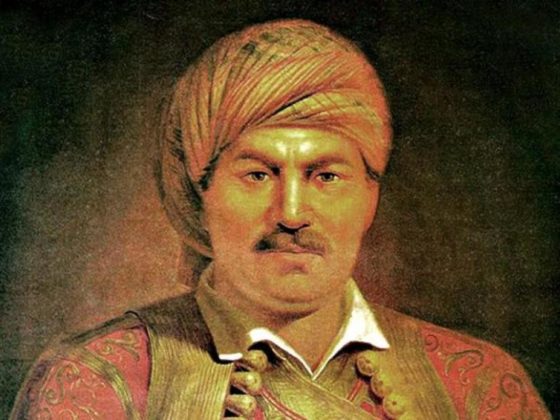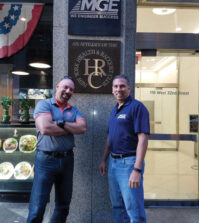- The Brothers Gerazounis: Engineering the Lifeblood of Buildings
- The Hellenic Initiative Summer Youth Academy Empowers Underprivileged Children Through Sports
- CAPTAIN MARIANTHI KASDAGLI: Charting her own course at sea
- Oscar nominee Lorraine Bracco of ‘Goodfellas’ is having ‘More Fun’ than ever before
- Voice And Vision: Grigoris Maninakis, 50 Years Of Greek Music In America
Serbs in The Greek Revolution
by Dean Kalimniou*
Ν΄ ἀνάψωμεν μία φλόγα, σὲ ὅλην τὴν Τουρκιά,
Νὰ τρέξ΄ ἀπὸ τὴν Μπόσνα, καὶ ὡς τὴν Ἀραπιά.
“We will light a flame throughout the Turkish lands
That will spread from Bosnia to Arabia.”
Rhigas Pheraios.
It is fair to say that the Serbians had a stake in the Greek Revolution and the Independence of Greece, even prior to 25 March 1821, with leaders of the Serbian people and key protagonists in, or veterans of the Serbian revolt, such as Serbian revolutionary leader Karadjordje, becoming sworn members of the Philike Etaireia.
Indeed, when the Greek Revolution was proclaimed, not in Greece, but in Moldavia in February 1821, Prince Alexander Ypsilanti’s forces were comprised of mixed Greek and Serbian fighters. Some of these were known for their ferocity. Captain Milenko Stojković, was renowned for having killed the Ottoman notables Aganlija, Kucuk Alija, Mula Jusuf and Mehmed Focic, responsible for the killing of Serbian Princes that triggered the First Serbian Uprising, arrived in Moldavia with his band of Serbian fighters and placed himself under Ypsilantis’ command. Petar Dobrnjac who had distinguished himself previously by defeating Ibrahim Bushati, pasha of Scutari at the battle of Deligrad and was one of the most important men in Serbian society, followed suit. Mladen Milovanović, prior to crossing the Danube to fight with Ypsilantis, served as the Prime Minister of Serbia and as a first Minister of Defence. The fearsome Prodan Gligorijević, known as Hadži-Prodan, on the other hand, after fighting in the First Serbian Revolt and another revolt he instigated of his own accord in 1814, also joined forces with Ypsilantis in 1821 in Wallachia, while mention is also made by chroniclers of an archimandrite “Servos,” probably his ethnonym, who also arrived from Serbia to fight for the Greek cause.

Vasos Mavrovouniotis, the most famous Serbian freedom fighter for Greece
The Greek revolt in the Danubian principalities, having to deal with competing Romanian nationalism and the Ottomans was an abject failure. After the subjugation of the rebels, Serbian fighters migrated south to Greece proper, in search of employment and as a means of evading punishment. One of these was the legendary female fighter Čučuk Stana, wife of the armatole Giorgakis Olympios, who was killed in the battle of Secu in Moldavia. Others, who we learn of from descriptions of battles, range from Constantine Nemanja, who claimed that he was a descendant of the royal Nemanjid line of Serbian medieval rulers, and would sign his correspondence as “Prince of Serbia” employed a seal that bore the double-headed eagle and was granted a pension of five loaves of bread a day, George Papazoglou, a cavalry officer under the command of Hatzi Christos, of Bulgarian ethnicity, who was killed in the battle, Radoš Mavrovouniotis (ie of Montenegro), while a list of fighters surnamed “the Serbian” such as Thomas Servos, Lambros Servos, Lambros Christou Servos and Thanassis Servos are recorded as having fought at the siege of Messolongi. Another twenty five Serbians are mentioned as having fought under the command of Captain George Kontopoulos in that most important of towns.
Of all of the Serbians who fought in the Greek Revolution, the one who perhaps left the greatest legacy, was Vaso Brajević, better known as Vasos Mavrovouniotis, who played a leading role in thirty six battles for the liberation of Greece. In 1821 leading a force of 120 Montenegrins and Greeks, he joined the early stages of the Greek revolution. Teaming up with his blood brother, Nikolaos Kriezotis, leader of the Greek Revolution in Euboea, he distinguished himself in fighting in Central Greece. In 1822 he participated in the battles against the Ottomans in Athens where he displayed great bravery and daring, being widely acclaimed as one of the best warriors of the time.
Having successfully navigated the minefields of the ensuing civil wars and coming out unscathed, he was assigned the rank of General and entrusted with a force of 1,500 fighter. Notably, between 1826-27 he was one of the few revolutionaries not to be defeated by the Egyptian forces led by Ibrahim Pasha, that devastated the Peloponnese and almost defeated the Revolution. Perpetually restless, he teamed up with Hatzimihalis Dalianis of Chimarra in Northern Epirus to participate in a daring but ultimately failed Greek expedition to Cyprus and Lebanon aiming at inciting revolution in the soft underbelly of the Ottoman Empire. His career having peaked, he eventually became a member of the Greek Privy Council and an adjutant to King Otto.
Other Montenegrin Serbs who followed Mavrovouniotis seemed to have been from the same area as he, the Bjelopavlići lowlands and they are also given the same surname in historical records. Thus, there are extant references to Ioannis Slavanos Mavrovouniotis, Ioannis Montenegrinos, who fought in the siege of Tripolitsa and Gregory Jurovic Mavrovouniotis. Historian William St Clair in his magisterial history of the Revolution: “That Greece Might Still be Free,” writes of a Montenegrin General with the Germanised name of de Wintz, who having fought under Napoleon, unsuccessfully attempted to unit of 2,000 European volunteers or mercenaries to fight in Greece, giving up after failing to secure the requisite financial assistance.
While in the beginning, Serbs tended to fight under their own leaders, with the effluxion of time, a sense of camaraderie developed between Greeks and Serbs and their units began to be mixed. The vast majority of these men were guerrilla fighters, while few, notably a mixed corps of 250 Greeks and Serbs led by the Serbian Stefos Nivitsa, formed a part of a tactical army under the command of the turban-toting French philhellene Charles Nicolas Fabvier.
There was no rosy-eyed Rhigas Pheraios fuelled dream of a Confederation of Balkan Peoples presided over by a dominant but benevolent Greece shared by these Serbian fighters. Many of them believed that one way to secure Serbian independence was to foment revolt in the South. Others, aligned with the Karadjordje faction of Serbian leadership, were in danger of their lives under the rule of their rivals, the Obrenović and thus found it expedient to seek refuge in Greece. Many still, as soldiers of fortune still do, travelled to where the action was, seeing payment, loot and privilege. In this regard, it is significant to note that after 1824 a good many Serbian fighters received commissions in the Greek Army, among them, general Hatzi Christos Dagović, battalion commanders (chiliarchs) Stefos and Anastasi Dmitrević, vice-chiliarch Jovo Mavrovouniotis, Captains Ioannis and Nikolaos Radović of Montenegro and the Serbians known only as Nikolzo, Kotzo, Helias, Spyros, and Karagiorgos.
The vast majority of the Serbs who survived the Revolution, did not return to Serbia. Instead, they settled in Greece, married local women and assimilated into the emerging society, in the same manner as their Greek counterparts who had fought in the earlier Serbian revolts. While public statues exist of Vasos Mavrovouniotis, the most famous Serbian freedom fighter for Greece, his compatriots barely rate a mention in the popular consciousness.
The vicissitudes of time and the accidents of fate have led here, so many years after the Greek and Serbian Revolutions, to the establishment of strong ties between Greek and Serbian migrant communities throughout the world. Yet despite our shared history and the enduring bonds of friendship that were forged as a result of a mutual commitment to liberty, bonds so strong that they led revolutionary Anastasios Karatasos of Imathia to advocate a dual Greek-Serbian state and veteran and historian Lambros Koutsonikas, to conceive of a Greek–Serbian federation of “two sisters,” the Serbian community is generally left out of commemorative events for the Greek revolution, and we neglect to pay homage to its heroes, male and female, who fought for and became adopted children of Greece.
There is still plenty of time for this omission to be redressed, in this bicentennial year of the Revolution, so that Rhigas Pheraios’ noble conviction that the pursuit of liberty and the destruction of tyranny is the task of all nations working together, can be honoured in full. Until then, we salute and remember our Serbian heroes with gratitude, awe and deep humility, praying always that their memory be eternal.















0 comments